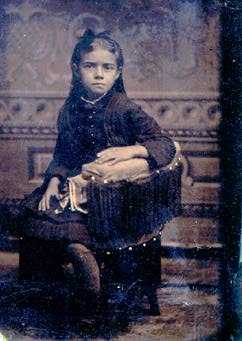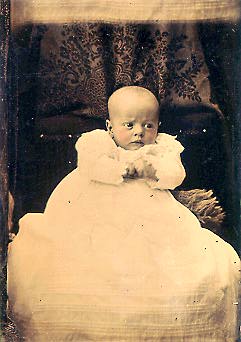

Expression is everything in a daguerreotype. All else,-the hair-jewelry-lace-work-drapery or dress, and attitude, are only aids to expression. It must at least be comfortable, and ought to be amiable. It ought also to be sensible, spirited and dignified, and usually with care and patience may be so. A little practice, with a friend to prompt, before a mirror, will save time, and very likely be the means of much increasing the satisfaction of those for whom the likeness is made. . . .
All lace-work should be light and thin, never massy; though it may be white or black to suit the occasion. Flowing curls for misses, over a low-necked dress, or for young ladies with handsome outlines of neck and shoulders, are picturesque and pleasing; but thin necks and projecting collar-bones require high dresses with lace, whether in fashion or not. The same remarks apply to arms and hands. If not well filled out, with good outlines, let them be appropriately covered in a picture. Simple je welry may be taken, but if heavy or massy, it is not admissible except for fancy pictures. If the figure is good the fashion of the dress should show all handsome lines or curves, and hide all that are not so. . . . Dark colors are generally more appropriate than light. Fair complexions may be taken in bridal or ball costume; and dark ones may if the figure is represented on a small scale. Remember that positive red, orange, yellow or green, are the same as black, or nearly so; and violet, purple and blue are nearly the same as white; and arrange your costume accordingly. Rich figured shawls or scarves and dresses usually show well in a picture. Full promenade, carriage, or riding dresses, look well as such, although not suited for a simple likeness.

Infants too young to sit upright, should be taken in their usual long frocks, but when a little older their feet need not be covered; but the whole figure may be prettily taken if they can be kept quiet four or five seconds. As a good rule, let the frock be very low in the neck, with short waist, not tight, yet fitting the form, reaching to the foot; the sleeves very short and loose, ornamented with narrow lace. The skirt should be of woollen fabric, not too full, reaching about half way from the knee to the ankle, and worked, figured or scalloped around the bottom. No other underclothing should be worn except of the thinnest and most pliable material. . . . .
Having disciplined the features of the face until controllable, select an hour for sitting when you may be in your best mental as well as physical condition. Prearrange dress and drapery in your most tasteful and graceful manner, so that it shall be at least to your own satisfaction. A figure laced to suffocation, a foot aching under the pressure of a too diminutive shoe, or the hair dr awn and twisted so tightly as almost to lift its wearer from the floor, thus imparting stiffness and awkwardness to expression even in repose, are but a few of the obstacles with which it will be useless for an Artist, however patient or earnest he may be , to contend.
The hour of departure on a tour of travel, a few hasty moments snatched from a shopping excursion in town, or between hurried morning calls and dinner, will not be likely to find one in a sufficiently fresh and quiet mood to yield to the hints the Artist may desire to throw out expressly for the sitter's benefit.
It has been said that " the most terrible enemy the Daguerreotype has to contend with, is human vanity." This is in a great degree truth. The repeated trials which the Artist finds it necessary to make to avoid Time's rude finger-marks, to overcome the ri gidity, languor, or sadness of expression, which disease or affliction may have produced, are among his difficulties and discouragements. Let not these be increased by the infelicities of time or condition above referred to. On your own account, as well a s for the sake of those who will value a correct portrait of yourself, choose the most favorable opportunity, as already suggested, and afford the Artist ample time, without haste or nervousness, for his labor.
Maintained by
jmnookin@bug.village.virginia.edu
URL: http://www2.iath.virginia.edu/ensp982/mnookin/ladies.html